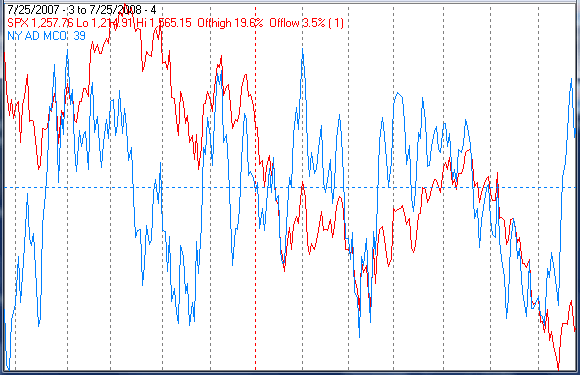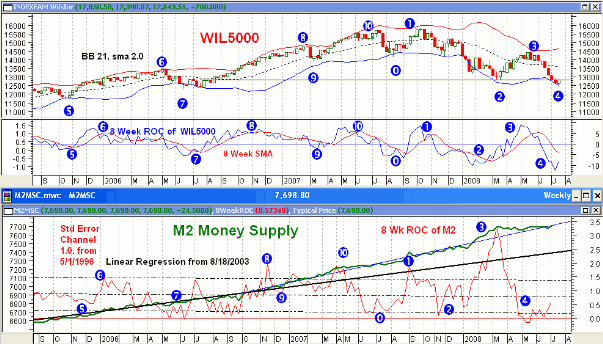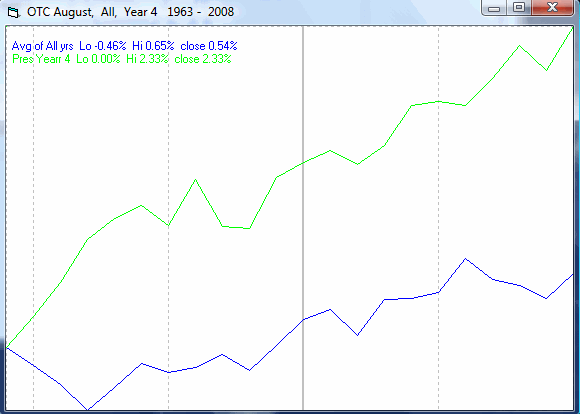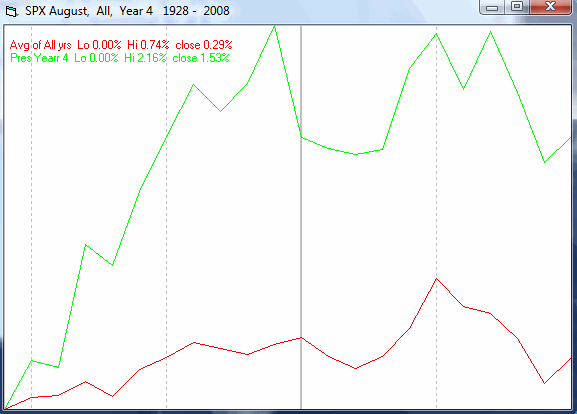Stock Market Short-term Overbought But Lows Should Hold
Stock-Markets / US Stock Markets Jul 27, 2008 - 04:28 PM GMTBy: Mike_Burk
The good news is: Since the low, a week ago last Tuesday, new lows have all but disappeared.
Short Term - The market is overbought. A variety of short term indicators hit their highest levels in a while.
This can be seen as relief in a down move or initiation of an up move.
The rapid decline in the number of new lows leads me to think it is the initiation of an up move.
The chart below covers the past year showing the S&P 500 (SPX) in red and the McClellan Oscillator in blue. Dashed vertical lines have been drawn on the 1st trading day of each month. The McClellan Oscillator is a 10% trend (19 day EMA) of daily NYSE advancing issues - declining issues subtracted from a 5% trend (39 day EMA) of the same.
Sharp upward moves in this indicator last August and November initiated rallies that lasted about 2 months and 2 weeks respectively.

Intermediate Term
There were 1304 new lows on the NYSE Tuesday July 15. That number dropped to 51 last Wednesday.
The chart below is an update of one shown last week. It covers the past year showing the SPX in red and a 10% trend (19 day EMA) of NYSE new lows (NY NL) in blue. NY NL has been plotted on an inverted Y axis so decreasing new lows move the indicator upward (up is good).

Intermediate term risk should be minimal until NY NL turns down again.
Seasonality
Next week is the week includes the last 4 trading days of July and the 1st trading day of August during the 4th year of the Presidential Cycle.
The tables show the daily return on a percentage basis for the last 4 trading days of July and the 1st trading day of August during the 4th year of the Presidential Cycle. NASDAQ composite (OTC) data covers the period from 1963 - 2007 and SPX data from 1928 - 2007. There are summaries for both the 4th year of the Presidential Cycle and all years combined.
The OTC over the coming week has had modest gains during the 4th year of the Presidential Cycle and modest losses over all years. The SPX has had a pretty good average gain during the 4th year of the Presidential Cycle helped by a 12.58% gain in 1932. Over all years the SPX has averaged modest gains.
Report for the last 4 days of July and first 1 day of August.
The number following the year represents its position in the presidential cycle.
The number following the daily return represents the day of the week;
1 = Monday, 2 = Tuesday etc.
| OTC Presidential Year 4 | ||||||
| Day4 | Day3 | Day2 | Day1 | Day1 | Totals | |
| 1964-4 | -0.34% 2 | 0.02% 3 | 0.05% 4 | 0.10% 5 | 0.05% 1 | -0.12% |
| 1968-4 | -0.84% 4 | -1.41% 5 | 0.21% 1 | -1.28% 2 | -0.32% 4 | -3.63% |
| 1972-4 | 0.14% 3 | -0.23% 4 | -0.16% 5 | -0.31% 1 | 0.55% 2 | -0.01% |
| 1976-4 | -0.20% 2 | -0.32% 3 | -0.18% 4 | 0.48% 5 | -0.02% 1 | -0.23% |
| 1980-4 | 0.23% 1 | 0.61% 2 | 0.74% 3 | -0.30% 4 | 0.40% 5 | 1.68% |
| 1984-4 | 0.78% 4 | 0.99% 5 | -0.15% 1 | 0.33% 2 | 1.59% 3 | 3.53% |
| Avg | 0.02% | -0.07% | 0.09% | -0.22% | 0.44% | 0.27% |
| 1988-4 | -0.34% 2 | -0.64% 3 | 0.20% 4 | 0.85% 5 | 0.17% 1 | 0.23% |
| 1992-4 | 1.22% 2 | 1.03% 3 | 0.23% 4 | 0.35% 5 | 0.26% 1 | 3.09% |
| 1996-4 | 1.60% 5 | -1.20% 1 | 0.52% 2 | 0.80% 3 | 1.68% 4 | 3.41% |
| 2000-4 | -1.04% 3 | -3.65% 4 | -4.66% 5 | 2.84% 1 | -2.16% 2 | -8.68% |
| 2004-4 | 1.64% 2 | -0.58% 3 | 1.23% 4 | 0.33% 5 | 0.25% 1 | 2.87% |
| Avg | 0.61% | -1.01% | -0.50% | 1.03% | 0.04% | 0.18% |
| OTC summary for Presidential Year 4 1964 - 2004 | ||||||
| Averages | 0.26% | -0.49% | -0.18% | 0.38% | 0.22% | 0.19% |
| % Winners | 55% | 36% | 64% | 73% | 73% | 55% |
| MDD 7/28/2000 9.10% -- 8/1/1968 3.59% -- 7/29/1996 1.20% | ||||||
| OTC summary for all years 1963 - 2007 | ||||||
| Averages | 0.03% | -0.14% | -0.03% | 0.01% | -0.09% | -0.22% |
| % Winners | 47% | 47% | 60% | 53% | 55% | 49% |
| MDD 7/28/2000 9.10% -- 8/1/1974 5.28% -- 7/31/1969 4.84% | ||||||
| SPX Presidential Year 4 | ||||||
| Day4 | Day3 | Day2 | Day1 | Day1 | Totals | |
| 1928-4 | 0.94% 5 | 0.26% 6 | 0.00% 1 | -0.21% 2 | -0.05% 3 | 0.94% |
| 1932-4 | 5.00% 3 | 3.17% 4 | 3.08% 5 | 1.16% 6 | 0.16% 1 | 12.58% |
| 1936-4 | -6.38% 2 | 5.56% 3 | 0.38% 4 | -1.06% 5 | 0.13% 6 | -1.38% |
| 1940-4 | 0.40% 6 | 0.70% 1 | 2.48% 2 | -0.39% 3 | -0.29% 4 | 2.90% |
| 1944-4 | 0.00% 4 | -0.55% 5 | 0.00% 6 | 0.08% 1 | 0.55% 2 | 0.08% |
| Avg | -0.01% | 1.83% | 1.19% | -0.08% | 0.10% | 3.02% |
| 1948-4 | 1.05% 2 | -0.68% 3 | -0.80% 4 | -1.25% 5 | 0.00% 1 | -1.67% |
| 1952-4 | 0.16% 1 | 0.24% 2 | 0.44% 3 | 0.12% 4 | 0.20% 5 | 1.15% |
| 1956-4 | 0.08% 4 | -0.81% 5 | -0.16% 1 | 0.80% 2 | 0.06% 3 | -0.03% |
| 1960-4 | 0.61% 2 | -0.62% 3 | 0.74% 4 | 1.72% 5 | 0.04% 1 | 2.48% |
| 1964-4 | -0.28% 2 | 0.08% 3 | 0.21% 4 | 0.11% 5 | -0.22% 1 | -0.10% |
| Avg | 0.33% | -0.36% | 0.08% | 0.30% | 0.02% | 0.37% |
| 1968-4 | -1.28% 4 | 0.41% 5 | -0.70% 1 | 0.09% 2 | -0.47% 4 | -1.95% |
| 1972-4 | -0.07% 3 | -0.23% 4 | 0.09% 5 | 0.01% 1 | 0.94% 2 | 0.75% |
| 1976-4 | -0.57% 2 | -0.42% 3 | -0.12% 4 | 0.50% 5 | -0.24% 1 | -0.85% |
| 1980-4 | 0.54% 1 | 0.80% 2 | -0.14% 3 | -0.46% 4 | -0.38% 5 | 0.36% |
| 1984-4 | 0.84% 4 | 0.74% 5 | -0.66% 1 | 0.31% 2 | 2.27% 3 | 3.50% |
| Avg | -0.11% | 0.26% | -0.31% | 0.09% | 0.42% | 0.36% |
| 1988-4 | 0.19% 2 | -1.01% 3 | 1.34% 4 | 2.26% 5 | 0.07% 1 | 2.84% |
| 1992-4 | 1.45% 2 | 1.13% 3 | 0.40% 4 | 0.07% 5 | 0.21% 1 | 3.26% |
| 1996-4 | 0.75% 5 | -0.79% 1 | 0.69% 2 | 0.74% 3 | 1.58% 4 | 2.97% |
| 2000-4 | -1.50% 3 | -0.19% 4 | -2.05% 5 | 0.77% 1 | 0.51% 2 | -2.46% |
| 2004-4 | 0.99% 2 | 0.05% 3 | 0.46% 4 | 0.12% 5 | 0.44% 1 | 2.07% |
| Avg | 0.38% | -0.16% | 0.17% | 0.79% | 0.56% | 1.73% |
| SPX summary for Presidential Year 4 1928 - 2004 | ||||||
| Averages | 0.15% | 0.39% | 0.28% | 0.27% | 0.28% | 1.37% |
| % Winners | 65% | 55% | 55% | 75% | 65% | 65% |
| MDD 7/28/1936 6.38% -- 7/28/2000 3.70% -- 7/30/1948 2.70% | ||||||
| SPX summary for all years 1928 - 2007 | ||||||
| Averages | 0.04% | 0.09% | 0.13% | 0.11% | 0.07% | 0.43% |
| % Winners | 58% | 54% | 62% | 63% | 55% | 58% |
| MDD 7/31/1933 6.84% -- 7/28/1936 6.38% -- 8/1/1974 6.23% | ||||||
Money Supply (M2)
The money supply chart was provided by Gordon Harms. Money supply growth has remained stagnant.

August
Over all years since 1963, the OTC, in August, has been up 62% of the time with an average gain of 0.6%. During the 4th year of the Presidential Cycle the OTC has been up 64% of the time with an average gain of 2.3% helped considerably by a 14.1% gain in 2000.
The chart below shows the average August over all years in blue and the average during the 4th year of the Presidential Cycle in green.
On average there are 21 trading days in a month. The chart has been calculated by averaging the daily gain of each of the 1st 11 trading days and the last 10. When there have been more than 21 trading days in the month some of the days in the middle were omitted. When there have been more than 21 trading days in the month some of the days in the middle have been counted twice. Dashed vertical lines have been drawn on the 1st trading day of the month and at 5 trading day intervals after that. A solid vertical line has been drawn on the 11th trading day, the dividing point.

Over all years since 1928, the SPX, in August, has been up 61% of the time with an average gain of 0.7%. During the 4th year of the Presidential Cycle the SPX has been up 65% of the time with an average gain of 2.9% helped considerably by a 37.3% gain (the largest for any month ever) in 1932.
The chart below is similar to the one above except it shows the average performance for the SPX in August. The average for all years is shown in red and the average for the 4th year of the Presidential Cycle is shown in green.

Conclusion
The market is overbought, but, the sharp decline in new lows should limit the downside for the short term.
I expect the major indices to be higher on Friday August 1 than they were on Friday July 25.
Last week the blue chips were down while the secondaries were up so I am calling last weeks negative forecast a tie.
Thank you,
By Mike Burk
To subscribe to this report : http://alphaim.net/signup.html
Gordon Harms produces a Power Point for our local timing group. You can get a copy of that at: http://www.stockmarket-ta.com/ .
Disclaimer: Mike Burk is an employee and principal of Alpha Investment Management (Alpha) a registered investment advisor. Charts and figures presented herein are believed to be reliable but we cannot attest to their accuracy. Recent (last 10-15 yrs.) data has been supplied by CSI (csidata.com), FastTrack (fasttrack.net), Quotes Plus (qp2.com) and the Wall Street Journal (wsj.com). Historical data is from Barron's and ISI price books. The views expressed are provided for information purposes only and should not be construed in any way as investment advice. Furthermore, the opinions expressed may change without notice.
Mike Burk Archive |
© 2005-2022 http://www.MarketOracle.co.uk - The Market Oracle is a FREE Daily Financial Markets Analysis & Forecasting online publication.




